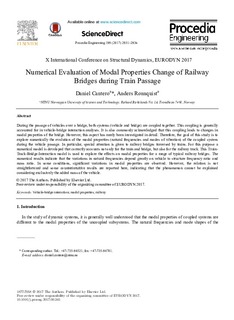Numerical Evaluation of Modal Properties Change of Railway Bridges during Train Passage
Journal article, Peer reviewed
Published version
Permanent lenke
http://hdl.handle.net/11250/2458984Utgivelsesdato
2017Metadata
Vis full innførselSamlinger
Originalversjon
10.1016/j.proeng.2017.09.345Sammendrag
During the passage of vehicles over a bridge, both systems (vehicle and bridge) are coupled together. This coupling is generally accounted for in vehicle-bridge interaction analyses. It is also commonly acknowledged that this coupling leads to changes in modal properties of the bridge. However, this aspect has rarely been investigated in detail. Therefore, the goal of this study is to explore numerically the evolution of the modal properties (natural frequencies and modes of vibration) of the coupled system during the vehicle passage. In particular, special attention is given to railway bridges traversed by trains. For this purpose a numerical model is developed that correctly accounts not only for the train and bridge, but also for the railway track. This Train-Track-Bridge-Interaction model is used to explore the effects on modal properties for a range of typical railway bridges. The numerical results indicate that the variations in natural frequencies depend greatly on vehicle to structure frequency ratio and mass ratio. In some conditions, significant variations in modal properties are observed. However, the relation is not straightforward and some counterintuitive results are reported here, indicating that the phenomenon cannot be explained considering exclusively the added mass of the vehicle.

